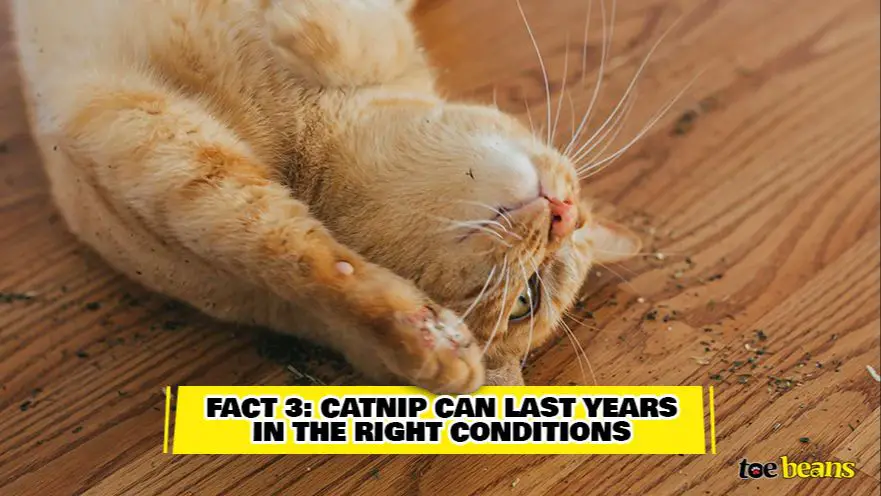Dangers of Giving Dogs Catnip
While catnip is generally considered safe for dogs, there are some potential dangers to be aware of before giving it to your canine companion.
Catnip contains a chemical called nepetalactone which can cause behavioral changes in cats, often making them hyperactive, playful or overstimulated. However, catnip does not have the same effect on dogs, and large amounts can actually cause anxiety or hyperactivity.
According to veterinarians, catnip can trigger an energetic, hyperactive state in dogs that can last for hours and cause anxiety or restlessness (1). The ASPCA advises to use catnip carefully with dogs, as the effects can be unpredictable (2).
Some potential side effects of too much catnip for dogs include hyperactivity, anxious behavior, gastrointestinal upset, or agitation. Catnip overdose can also cause dogs to become very stressed or overly aggressive. Therefore, it’s important to monitor your dog closely and avoid giving large doses of catnip.
Additionally, some dogs may have an allergic reaction to catnip. Signs of an allergic reaction include itchy skin, hives, diarrhea, vomiting, wheezing, and swelling of the lips, eyelids, face or extremities.
Sources:
(1) https://www.rover.com/blog/is-catnip-safe-for-dogs/
(2) https://www.aspca.org/pet-care/animal-poison-control/toxic-and-non-toxic-plants/catnip
Why Dogs May Enjoy Catnip
Catnip contains a compound called nepetalactone, which is similar to dog pheromones1. This compound binds to olfactory receptors in a dog’s nose, producing a mild euphoric effect2. Though catnip does not have the same strong effect on dogs as it does on cats, some dogs still seem to enjoy and react to the smell and taste of catnip.
The pheromone-like properties of nepetalactone likely explain why some dogs spend time sniffing, licking, or even eating catnip toys or treats. The herb makes them feel relaxed, content, and mildly “high.” It activates the brain’s pleasure centers in a very gentle way.
However, most evidence suggests catnip does not actually sedate dogs or have as dramatic an effect as it does on cats. But some dogs may still take an interest in it and derive enjoyment from its unique scent and flavor.
Suggested Catnip Dosages for Dogs
When giving catnip to dogs, it’s important to start with very small amounts and monitor your dog’s reaction. Catnip dosages will vary based on the size of your dog.
For small dogs under 20 lbs, start with just a pinch or 1/8 teaspoon of dried catnip. For medium dogs 20-50 lbs, start with 1/4 teaspoon. For large dogs over 50 lbs, start with 1/2 teaspoon.

Give the starting amount and observe your dog for 15-20 minutes. If they seem to enjoy it and don’t show any adverse effects, you can give them a little more, increasing the dose gradually over time. But do so slowly and cautiously, especially when first introducing catnip.
According to veterinarians, the maximum suggested dosage per day, even for large dogs, is around 1-2 teaspoons. It’s important not to exceed this, as too much catnip can cause vomiting, diarrhea or hyperactivity (Source).
Every dog will have a different tolerance based on size, sensitivity and personal preference. Monitor their reaction closely and adjust the dosage to keep them comfortable and content.
Potential Benefits of Catnip for Dogs
Some research suggests catnip may have a calming effect on dogs. The active ingredient in catnip, called nepetalactone, binds to receptors in a dog’s nose and triggers a response that can relax and soothe anxiety or stress. Some potential benefits of using catnip for dogs include:
- May help relieve anxiety, fearfulness, or nervousness such as during thunderstorms, fireworks, travel, or visits to the vet.
- Could potentially aid with separation anxiety when a dog is left alone.
- Some owners report it helps puppies sleep better overnight.
- May relieve symptoms of hyperactivity or restlessness.
It’s important to note the calming effects can vary widely between individual dogs. Some dogs may become more energetic or playful after exposure to catnip. It’s recommended owners experiment carefully with small amounts to gauge their dog’s response. Consult with your vet before using catnip for anxiety issues.
Sources:
https://animalwellnessmagazine.com/catnip-is-good-for-dogs-too/
https://blog.healthypawspetinsurance.com/is-catnip-safe-for-dogs
Risks of Catnip Overdose
While catnip is not typically toxic to dogs, giving your dog too much catnip can result in an overdose with unpleasant side effects. The most common symptoms of a catnip overdose in dogs include:

- Nausea
- Vomiting
- Diarrhea
- Drooling
- Lethargy
Consuming large amounts of catnip can upset your dog’s stomach and digestive system, leading to gastrointestinal issues like vomiting and diarrhea. The chemical compounds in catnip responsible for the herb’s effects on cats can cause excessive drooling and lethargy at high doses in dogs.
According to veterinarians, signs of catnip toxicity usually subside within 6-8 hours as the effects of the herb wear off. However, if your dog has persistent vomiting, diarrhea, or lethargy after ingesting catnip, you should take them to the vet for evaluation (Source). With prompt veterinary treatment for dehydration and other complications, dogs typically make a full recovery from catnip overdose.
Signs of Catnip Toxicity
While catnip is generally considered safe for dogs, consuming too much can result in signs of toxicity. Some common symptoms of catnip overdose in dogs include:
Agitation or hyperactivity – Catnip can cause excitability in dogs, so an overdose may result in agitation, restlessness, anxiety, and hyperactivity.
Vomiting and diarrhea – Eating too much catnip can upset a dog’s stomach and digestive system, leading to nausea, vomiting, and diarrhea.
Lethargy – While small doses stimulate activity, large amounts of catnip can have a sedating effect and make dogs very lethargic.
Lack of coordination – Overdose can affect motor control, balance, and coordination in dogs. They may have trouble walking or seem disoriented.
Dilated pupils – Catnip causes pupil dilation in dogs, so very enlarged pupils could signal toxicity.
Drooling – Excessive drooling or salivation sometimes occurs with catnip overdose.
Trembling or shaking – Some dogs may tremble or shake if they consume too much catnip.
While most signs of toxicity are mild, a very large overdose could potentially cause more serious effects. It’s important to monitor your dog closely if they ingest a large amount of catnip and call your veterinarian if you have any concerns.
Sources:
https://www.rover.com/blog/is-catnip-safe-for-dogs/
https://greg.app/catnip-toxic-to-dogs/
How to Administer Catnip Safely
When giving catnip to dogs, it’s important to start with small amounts and monitor them closely to avoid overdose. Here are some tips for administering catnip safely to dogs:
Start with a small pinch or sprinkle of dried catnip. Give 1/4 to 1/2 teaspoon for small dogs, 1/2 to 1 teaspoon for medium dogs, and 1-2 teaspoons for large dogs. Too much catnip can cause dogs to become overly excited or anxious.
Mix catnip in with their food or treats. This helps distribute it evenly and prevents them from eating too much at once. Make catnip treats by sprinkling a small amount into peanut butter or mixing it into homemade dog treats.

Monitor your dog closely after giving them catnip. Watch for signs of excessive hyperactivity, anxiety, vomiting or diarrhea which could indicate they’ve had too much. Effects typically last 30-60 minutes.
Store catnip safely out of your dog’s reach, since they may try to get into it if left unsupervised. Only give catnip under your supervision.
Rotate catnip with other calming aids like chamomile or CBD oil. Using catnip daily can cause dogs to develop a tolerance.
Never force your dog to eat catnip if they show no interest. Most dogs enjoy it, but some may not respond at all.
Speak with your vet before giving catnip if your dog is on medication or has health conditions. Stop giving it if you notice any adverse effects.
With proper dosing and monitoring, catnip can be administered safely to most dogs for its calming and relaxing effects.
Alternatives to Catnip
While catnip is enjoyed by many dogs, there are some natural alternatives that can provide a similar stimulating and calming effect. Some popular catnip alternatives for dogs include:
Chamomile – This herb has a gentle, calming scent that many dogs enjoy. It can help relieve anxiety and aid sleep (The Spruce Pets).
Valerian Root – The root of this flowering plant has been used in herbal medicine to reduce stress and nervousness. It may help hyperactive dogs relax (WebMD).
Cat Thyme – This plant is similar to catnip but may produce a more mellow reaction in dogs. It has a lemon scent dogs often find soothing (AKC).
Anise – The licorice scent of anise seeds can act like catnip for dogs. Anise may stimulate play, happiness, and even relieve digestive issues (The Spruce Pets).
These natural alternatives can provide a fun and safe way to engage and relax dogs without the intense stimulation of catnip. However, consult a vet before introducing new herbs, especially with dogs on medication.
When to Call the Vet
If signs of toxicity occur after your dog consumes catnip, you should call your veterinarian immediately. According to the ASPCA, signs of catnip toxicity can include vomiting, diarrhea, excessive drooling, hyperactivity and agitation.1 More severe symptoms may include tremors, seizures, difficulty breathing, an elevated heart rate and fever. If your dog displays any of these concerning symptoms after eating catnip, don’t hesitate to contact your vet or an emergency animal hospital right away. The sooner you seek treatment, the better the outcome is likely to be.
Some sources advise calling your vet if your small dog consumes more than 1/4 teaspoon of catnip, or if your large dog consumes more than 1 teaspoon.2 However, every dog is different, so pay close attention to any changes in behavior or concerning symptoms. Your vet can guide you on the right course of action based on your specific situation.

It’s always better to err on the side of caution when it comes to potential toxicity. Don’t wait to see if symptoms pass – promptly contact your vet at the first sign of trouble after your dog ingests catnip. With rapid veterinary treatment, most dogs fully recover from catnip overdoses once the toxins clear their system.
Conclusion
Catnip can be an enjoyable treat for some dogs when given in moderation. The key takeaways are:
- Catnip is generally safe for dogs, but consult your vet first.
- Only give small amounts based on your dog’s weight.
- Monitor your dog closely for overdose symptoms.
- Try alternatives like peanut butter or rice crackers if your dog doesn’t enjoy catnip.
- Never force your dog to ingest catnip if they don’t want it.
- Store catnip securely so your dog can’t get into it.
While catnip may provide a temporary high, it’s important not to overdo it. Practice moderation and safe storage to ensure your dog has fun without adverse effects. If in doubt, skip the catnip and reward your dog with their favorite healthy treat instead.

